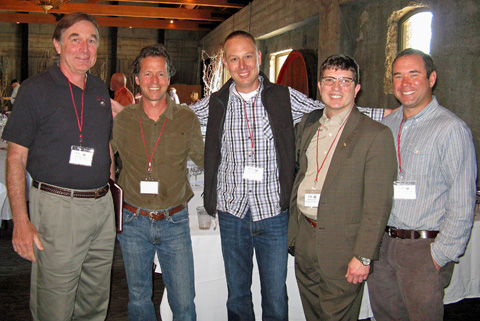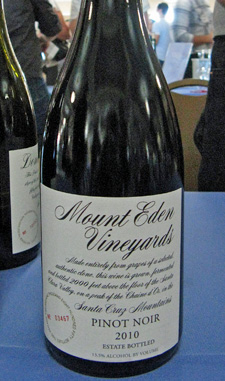I attended the Santa Cruz Mountains Pinot Paradise event in late March, and wrote a report for the Grape-Nutz.com website. A portion of the report is below – there are more comments, detailed notes on the Technical Session, photos, and tasting notes on 70 wines from 34 producers here:
Pinot Paradise, March 2013 – Technical Session and 9th Annual Grand Cruz Tasting
Report on the 9th annual Pinot Paradise presented by the Santa Cruz Mountains Winegrowers Association, from Friday March 22nd through Sunday March 24th, 2013. The event focuses on Pinot Noirs from the Santa Cruz Mountains AVA.
Pinot Paradise started with a Technical Session at The Mountain Winery in Saratoga on Friday, March 22nd, followed by a winemaker dinner at the same venue. It also included the Pathway to Pinot Paradise on Saturday, with special tastings at nearly 20 wineries throughout the region, followed by another winemaker dinner, this one at Shadowbrook Restaurant in Capitola. The grand finale to Pinot Paradise was the Grand Cruz Tasting at Villa Ragusa in Campbell on Sunday afternoon. I attended the Technical Session and the Grand Cruz Tasting.
The Santa Cruz Mountains Winegrowers Association helps to promote wineries and wines from the area. The Santa Cruz Mountains AVA was established in 1981, and includes parts of Santa Cruz, Santa Clara, and San Mateo counties. Vineyard elevations in the AVA range from 400 feet to over 3,000 feet, with some sites lying below the “fog line” and some above – the varied subregions of the AVA feature a number of different soil and climate profiles. Given the mountainous terrain, it’s no surprise that most vineyards in the region are small, with a total planted area of only around 1,500 acres. And with their close proximity to forested land, wildfires are always a concern, and many growers continue to do battle with the Glassy-winged Sparpshooter insect, which can spread Pierce’s Disease to the vines. Yet the growing number of vineyards and wineries in the area that are willing to brave these difficulties is a testament to the promise of these mountain wines. Over 70 wineries, most of them quite small and family-run, are currently members of the Santa Cruz Mountains Winegrowers Association.
Technical Session
The Friday afternoon Technical Session was hosted by The Mountain Winery, in the hills above Saratoga. This is one of California’s most notable winery sites, with a history that stretches back to legendary vintners Paul Masson and Martin Ray. Entitled “Minerality – Taste and Terroir,” the Technical Session covered a topic that seems to be on more and more people’s minds over the past few years. The session began with an interesting presentation by Dr. James Kennedy of the Department of Viticulture and Enology at California State University in Fresno. He pointed out that there is no widely-accepted definition of minerality in wine, let alone agreement on what causes it. Is minerality an aroma, a flavor, a tactile sensation on the palate, or something else? And the fact that “minerality” as a wine descriptor can mean completely different things to different people doesn’t help matters.
Following Dr. Kennedy’s presentation was a panel discussion moderated by wine educator David Glancy, founder of the San Francisco Wine School, and featuring winemakers Duncan Meyers of Arnot-Roberts, Bradley Brown of Big Basin, Nathan Kandler of Thomas Fogarty, and Jim Schultze of Windy Oaks. Each of the winemakers presented one of their single-vineyard Pinots that they felt displayed minerality. I felt it was interesting that all of the wines used a fair percentage of whole clusters – two were about 25% and two were 100% – and all underwent at least some native (non-inoculated) yeast fermentations, with three of the four being 100% native.

The final part of the Technical Session was a look at the wines of Calera. Though not in the Santa Cruz Mountains, Calera’s Pinot Noirs are often noted for their minerality, thought by many to result from the limestone soils at the winery’s Mount Harlan vineyards in the Gabilan Mountains of San Benito County.
Overall, I thought the Technical Session was illuminating and very much worthwhile, and all of the presenters lent a somewhat different take on the subject of minerality in Pinot Noir, and how that relates specifically to the Pinots of the Santa Cruz Mountains.
Grand Cruz Tasting
I was looking forward to this year’s Pinot Paradise Grand Cruz Tasting since I had been unable to attend the event for the past few years. As always, the event afforded an excellent opportunity to taste Pinot Noirs from many Santa Cruz Mountains producers.
Although the Grand Cruz Tasting presents a broad overview of Pinot Noir from the Santa Cruz Mountains, it has to be noted that many of the region’s better-known – and in many cases, higher-quality – producers did not pour at this year’s event. These included: Rhys, Varner/Neely, McHenry, Soquel, Downhill, Stefania, Sarah’s Vineyard, and Windy Oaks (although they did participate in the Technical Session and in the Pathway to Paradise). While there may be many valid reasons for a producer’s decision not to pour at the Grand Cruz Tasting, it can’t help but skew a taster’s perception of the region given that so many fine producers opt out.
Nevertheless, the Grand Cruz Tasting continues to be a very rewarding event. It was interesting to taste Pinots made by various producers using fruit from some of the same vineyard sources – Muns, Lester Family, Alfaro Family, and Regan being noteworthy vineyard examples. Many other wines were made from producers’ own small estate plantings. There also seems to be a move toward better vineyard management in the region, with people like noted viticulturist Prudy Foxx helping to lead the way, and I think this showed in some of the latest wines compared with those from just a few years ago. And although I thought the wines in general were a step up from what I tasted at my previous Grand Cruz Tastings, there’s little question that winemaking in the region on the whole still has room for improvement. Too much new oak overwhelmed the delicate fruit of many of the Pinots (often this was Hungarian or American oak), and the notoriously tannic nature of Santa Cruz Mountains fruit could seemingly have been better-managed in many cases. But as I’ve found in some other California wine regions, incentives for making improvements may not be clear, nor is it always an easy matter for producers – particularly some of the small, family-owned ones – to make the investments that are often needed to produce better wines. That being said, I do think that things are moving in the right direction and quality across the board is headed upwards.
Consistent standard-bearers of recent years continued to lead the pack at the Grand Cruz Tasting, including Big Basin, Mount Eden, Santa Cruz Mountain Vineyard, and Thomas Fogarty. Other wineries of note included Alfaro, Clos LaChance, Hallcrest, Kings Mountain, and Muns. Among the newer Pinot producers at this event, I thought that House, The Mountain Winery, Sante Arcangeli, and Silvertip showed particular promise. Mount Eden’s Jeffrey Patterson makes the wines for both House and The Mountain Winery, and his winemaking skill showed in these Pinots. It should also be noted that some very good Santa Cruz Mountains Pinots are being made these days by producers from outside the AVA, including Arnot-Roberts, Wind Gap, and Ghostwriter. In general, the 2010 wines poured at the event were showing quite well and I expect that the 2011 vintage will follow suit.
Pinot Noir from the Santa Cruz Mountains can be highly distinctive, and a number of the wines at the Technical Session and the Grand Cruz Tasting demonstrated this very well. I find them generally lighter in color, higher in acidity and tannin, red-fruited and often earthy or minerally – whatever that term means! The Santa Cruz Mountains is a region with great potential for Pinot Noir that is yet to be fully realized on a wide scale. The standout wines of the Grand Cruz Tasting displayed how high the bar can be set for quality Pinots from the area – I’m hopeful that we’ll see more producers reaching that level in the future.
Favorites
Big Basin 2010 Alfaro Family Vineyard Pinot Noir
Cinnabar 2011 Santa Cruz Mountains Pinot Noir
Clos LaChance 2009 Santa Cruz Mountains Pinot Noir
House 2011 Estate Pinot Noir
Kings Mountain 2005 Estate Pinot Noir
Mount Eden 2010 Estate Pinot Noir
The Mountain Winery 2010 Estate Pinot Noir
Muns 2009 Estate Pinot Noir
Santa Cruz Mountain Vineyard 2010 Branciforte Creek Vineyard Pinot Noir
Thomas Fogarty 2010 Rapley Trail Vineyard Estate Pinot Noir
Others of Note
Alfaro 2011 Lester Family Vineyard Pinot Noir
Big Basin 2010 Lester Family Vineyard Pinot Noir
Black Ridge 2008 Santa Cruz Mountains Pinot Noir
Hallcrest 2009 Vista del Mare Vineyard Pinot Noir
Nicholson 2010 “Brook’s Block” Estate Pinot Noir
Sante Arcangeli 2011 “Corralitos Duet” Pinot Noir
Silvertip 2009 Estate Pinot Noir
Thomas Fogarty 2011 Santa Cruz Mountains Pinot Noir
